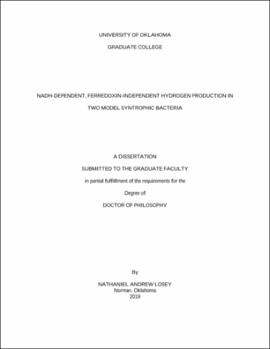| dc.contributor.advisor | McInerney, Michael | |
| dc.contributor.author | Losey, Nathaniel | |
| dc.date.accessioned | 2019-05-03T19:35:17Z | |
| dc.date.available | 2019-05-03T19:35:17Z | |
| dc.date.issued | 2019-05-10 | |
| dc.identifier.uri | https://hdl.handle.net/11244/319558 | |
| dc.description.abstract | The relationship between a fatty acid-oxidizing, hydrogen-producing bacterium and a hydrogen consuming methnogenic partner has longed served as a model system for anaerobic syntrophic metabolism. This process is dependent on low hydrogen and formate concentrations maintained by the methanogenic partner to allow the fatty acid-oxidizing bacterium to continually re-oxidize cofactors such as NADH that are generated by fatty acid oxidation. Two multimeric [FeFe]-hydrogenases from two different syntrophic model organisms, Syntrophomonas wolfei and Syntrophus aciditrophicus were produced by heterologously expressing the genes encoding for two [FeFe]-hydrogenase and genes for [FeFe]-hydrogenase maturation in Escherichia coli. The S. wolfei recombinant Hyd1ABC was found to consist of three subunits Hyd1A, Hyd1B, and Hyd1C with molecular weights of 63.0 kDa, 43.0 kDa and 13.0 kDa. S. wolfei Hyd1ABC was observed as a heterotrimer with an configuration and a molecular mass of 115 kDa. The S. aciditrophicus purified recombinant HydAB consisted of two subunits HydA and HydB with molecular weights 68.5 kDa and 66.0 kDa and suggested to consist of a α2β2 configuration. Both the S. wolfei Hyd1ABC and S. aciditrophicus HydAB were found to re-oxidize the cofactor NADH in a ferredoxin-independent manner. These NADH-dependent, ferredoxin-independent hydrogen production mechanisms provide S. wolfei and S. aciditrophicus with an energetic advantage under syntrophic conditions compared to the alternative which is NADH-dependent, ferredoxin-dependent electron confurcating hydrogen production. It is proposed that several differences in conserved residues within the HydB subunits are responsible for the observed ferredoxin-independent nature of these enzymes. These results demonstrate that NADH-dependent, ferredoxin-independent hydrogen production occurs in two phylogenetically distant organisms, S. wolfei a member of the phylum Firmicutes and S. aciditrophicus a Deltaproteobacteria. This suggests a unifying theme for syntrophic fatty acid-oxidizing bacteria, in the form of NADH-dependent, ferredoxin-independent hydrogen production.
Hydrogen partial pressures determined during pure culture and co-culture growth suggest that both S. wolfei and S. aciditrophicus must maintain high NADH/NAD+ ratios for NADH-dependent, ferredoxin-independent hydrogen production. NADH-dependent, ferredoxin-independent hydrogen production completes the pathway for how high redox potential electrons generated from 3-hydroxyacyl-CoA oxidation are used to produce hydrogen. It could be suggested that the observed dependence of syntrophic metabolizers on a hydrogen consuming partner is the result of a dependence on cofactor re-oxidation methods that utilize specifically high redox potential electrons. Other syntrophic metabolisms may be predicted to rely on mechanisms for re-oxidizing cofactors that also specifically utilize high redox potential electrons for hydrogen and formate production or direct interspecies electron transfer. | en_US |
| dc.language | en_US | en_US |
| dc.subject | Syntroph | en_US |
| dc.subject | hydrogenase | en_US |
| dc.subject | methanogenesis | en_US |
| dc.title | NADH-DEPENDENT, FERREDOXIN-INDEPENDENT HYDROGEN PRODUCTION IN TWO MODEL SYNTROPHIC BACTERIA | en_US |
| dc.contributor.committeeMember | Callaghan, Amy | |
| dc.contributor.committeeMember | Dunn, Anne | |
| dc.contributor.committeeMember | Krumholz, Lee | |
| dc.contributor.committeeMember | Markham, Michael | |
| dc.date.manuscript | 2019-04-30 | |
| dc.thesis.degree | Ph.D. | en_US |
| ou.group | College of Arts and Sciences::Department of Microbiology and Plant Biology | en_US |
| shareok.nativefileaccess | restricted | en_US |
